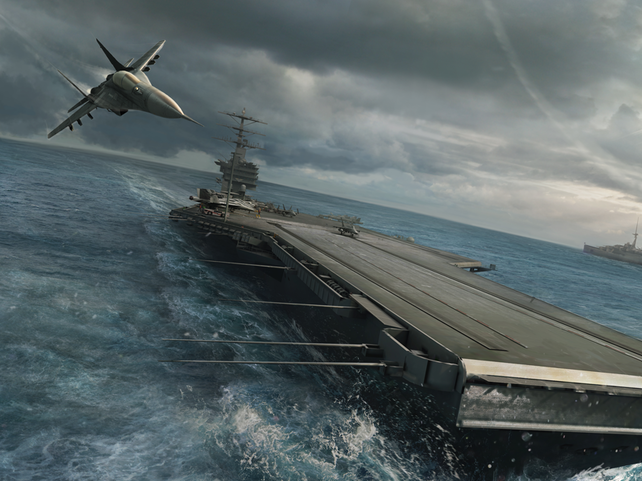
Militaries around the world are having to keep up with major technological advancements in equipment and operate in complex and dynamic environments, including non-traditional threats and the growth of information warfare. The pace of change is so fast that traditional training methods are no longer able to reflect the new operational reality.
In response to this challenge, sophisticated simulation technology is being readily applied to allow navies and other forces to adapt the delivery of training and mission rehearsal such that it is more relevant to modern, complex operations.
Some armed forces also have to conduct operations which are unfamiliar to them using new technology. As an example, many navies are now investing in a new anti-submarine warfare (ASW) capability, with limited prior operational experience in the domain. This creates a significant challenge: how to cost-effectively teach a new set of ASW knowledge, skills and attitudes to commanders, operators and equipment maintainers.
Although global military budgets are typically remaining healthy, when it comes to training, militaries are often forced to ‘do more with less’. In the face of this challenge, the application of simulation-based training presents a number of factors that amount to a considerable business case when compared to traditional methods.
Limitations of the classroom model
Previously, training courses may have been conducted within a classroom environment around a piece of physical equipment. However, in recent times, the availability of these physical assets has been reduced and the huge cost of dedicating equipment solely to training means that this may no longer be a viable option.
Similarly, the military is increasingly looking to provide training at a time and place that can be tailored to a particular student. It wants to prioritise flexible, student-centred learning that can help to reduce skills fade through timely refresher training and also enable training delivery whilst service personnel are deployed on operations, for example on board a ship. The more a student can practice and familiarise themselves with specific operational procedures, the less likely they are to suffer from skills fade.
Simulation-based training is therefore gaining momentum because it is a cost-effective, flexible and accessible method which supports de-centralised training. What’s more, it can provide accurate user content for emergency or fault scenarios that would be impractical or unsafe to create within a classroom or in live situations. It can also be tailored to a specific student or skill, providing greater focus on specific training objectives where the student requires more support.
When combined, these factors provide a strong business case for the use of simulation-based procedural training – as an example, the use of SEA’s DECKsim system has reduced the cost of training Flight Deck Officers by more than 50% when compared to training using live helicopters.
Applied technology from gaming and beyond
Technology has come so far in recent years. Developers have adopted the incredibly vivid gaming hardware and software technology and re-purposed it to deliver safe, efficient and high-fidelity immersive training. Simulation-based training aims to be physically and environmentally faithful to the scenario and functionally straight-forward.
Physical fidelity can be provided by a combination of visual, audio and motion cues via 3D image generation/graphics, projection systems, virtual reality (VR) headsets and audio systems. Electric and hydraulic motion bases, vibration platforms and haptic devices also help to recreate the sense of movement by applying forces, vibrations, or motions to the user.
Simulations provide environmental fidelity by considering lighting effects, weather effects and topography. Modern image generation systems, often developed via the computer gaming industry, are capable of producing highly quality visual representations of weather effects, such as rain, snow, wind and fog. In addition, the physical effects that the weather may have upon an activity, for example reducing sensor detection range, can be replicated within modern simulation systems.
Simulation-based training may also use high resolution terrain databases which include accurate regional and seasonal vegetation types to increase the realism. For maritime applications, physically realistic sea states and sub-surface representations can also be adopted to ensure the vessel operations are appropriate.
Tailoring simulations to specific situations
Whenever simulation-based training is developed for the military, the physical, environmental and functional requirements of the application should be evaluated. The training requirement will determine whether a piece of equipment is required to be represented in a spatially and visually accurate manner or whether the procedures are carried out during the day, at night or in different weather conditions.
Additionally, specific operational functions may be required to be represented to a high degree of accuracy – all of these elements are factored into the design of the training system.
Simulated systems are particularly effective for training scenarios that have a high degree of difficulty (that is, involving a large number of complex procedural steps or interactions), have a high level of importance (for example, involving mission or safety critical equipment or operations), or are conducted infrequently which means there is an increased risk of skills fade over time.
When seen in this light, it is not surprising that many forces are applying sophisticated simulation technology to enhance their training delivery. It is an effective training solution that reduces reliance upon physical hardware and provides a more flexible approach at lower cost. It can be delivered via web technologies and enables student-centred learning.
Furthermore, the flexibility of procedural training systems allows students to become proficient in a wider range of emergency and hazardous scenarios that would be impractical or dangerous to train under real conditions. We believe the use of simulation training will become more and more central to the training of military personnel and as technology continues to evolve, the gap in fidelity between the simulation and reality will continue to close.



